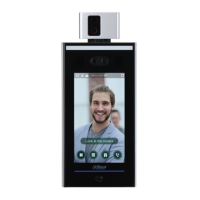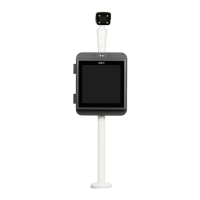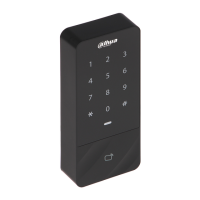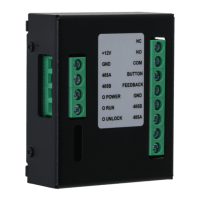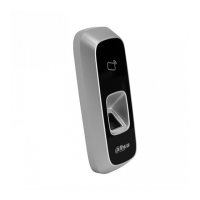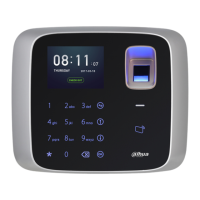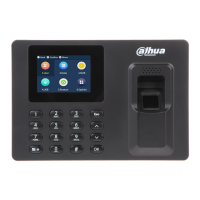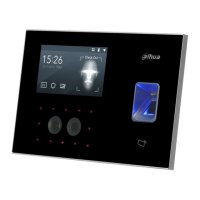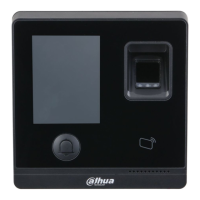
Do you have a question about the Dahua DHI-ASI7213Y-V3-T1P and is the answer not in the manual?
| Model | DHI-ASI7213Y-V3-T1P |
|---|---|
| Type | IP Access Controller |
| ROM | 8 GB |
| Operating System | Linux |
| Screen Size | 7 inch |
| Screen Type | LCD |
| Camera | 2 MP |
| FAR | ≤0.001% |
| FRR | ≤0.1% |
| Network Protocol | TCP/IP |
| Communication Interface | RS-485, Wiegand |
| RS-485 | 1 |
| Alarm Input | 2 |
| Alarm Output | 2 |
| Exit Button | 1 |
| Door Contact Detection | 1 |
| Lock Control | 1 |
| Operating Voltage | 12 VDC |
| Protection Grade | IP65 |
| Installation | Surface Mount |
| Processor | Embedded Processor |
| Unlock Mode | Face, Fingerprint, Password, Card |
| Card Type | IC card |
| Card Reading Distance | 0-5 cm |
| Fingerprint Reader | Optical |
| Fingerprint Verification Mode | 1:N |
| Fingerprint Verification Time | <0.5 s |
| Face Verification Distance | 0.3 m–1.5 m |
| Face Verification Height Range | 1.2-2m |
| Network | 10/100 Mbps Ethernet |
| Wiegand | Wiegand input/output |
| Doorbell | 1 |
| Access Control Interface | Electric lock, Exit button, Door sensor |
| Input Voltage | 12 VDC |
| Operating Temperature | -10°C to +55°C (+14°F to +131°F) |
| Operating Humidity | 10% to 90% |
| Humidity | 10% to 90% |
| Supported Readers | IC/ID card, Fingerprint, Face |
| Certifications | CE, FCC |
Manual introduction to the access controller and usage guidelines.
Explains signal words used in the manual for hazard identification.
Details versions of the manual and their release dates.
Outlines responsibilities regarding personal data collection and privacy laws.
Guidelines for transporting the access controller under specific conditions.
Instructions for storing the access controller under specific conditions.
Critical safety and operational requirements for installing the device.
Basic description of the face recognition access controller.
Lists the key functionalities and specifications of the device.
Describes where the access controller can be used.
Details the physical size and parts of the device.
Describes how to connect various external devices to the controller.
Provides recommendations for optimal device placement and environment.
Step-by-step guide for physically mounting the access controller.
Outlines the initial setup steps for the system.
Explains the meaning of icons used in the system interface.
Details the first-time setup process for administrator and email.
Describes the idle state of the device and unlock methods.
Overview of the primary navigation and functions available.
Explains how users can unlock the door using different credentials.
Covers adding, viewing, and managing user accounts.
Details controlling access via periods, unlock modes, and alarms.
Configuration for network connectivity, ports, and protocols.
Covers system-level settings like time, face parameters, and image modes.
Steps to configure the device via a web browser for the first time.
How to access and log into the web interface.
Procedure to recover or change the administrator password.
Configuration of how the system responds to alarm events.
Information on the maximum number of users, cards, and faces stored.
Configuration of video parameters like data rate and image quality.
Settings to optimize face recognition accuracy and performance.
Configuration of IP address, DNS, and other network parameters.
How to configure time, date, and NTP synchronization.
Settings related to IP authority and system services for security.
Managing user accounts and their permissions via the web interface.
Procedures for rebooting and testing the device.
Importing/exporting configuration files and feature settings.
Methods for updating the device firmware.
Displays details about the device's software and hardware versions.
Shows currently logged-in users on the system.
Viewing and backing up system event logs.
Tips for optimal face capture quality and recognition.
Steps and guidance for capturing user faces.
Guidance on proper user positioning for face recognition.
Specific criteria for faces to ensure successful recognition.
Guidelines for creating secure and robust passwords.
Importance of keeping software up-to-date for security.
Recommendations for securing the physical device.
Advice on regularly updating passwords.
Guidance on password recovery setup.
How to enhance account security by enabling lock features.
Recommendations for securing network ports.
Importance of using secure HTTPS for web access.
How to prevent spoofing by binding IP and MAC addresses.
Best practices for user account management.
Recommendations for minimizing security risks.
Securing data transmission through encryption.
Tips for monitoring user activity and system logs.
Importance of network logging for tracing and security.
General advice for building a secure network.
